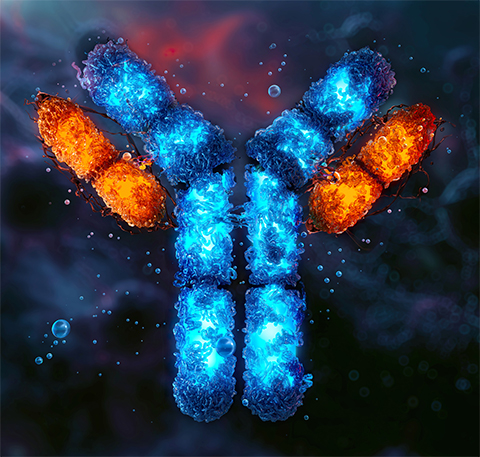Antibodies inhibit hyperactive protein disposal
A system of ubiquitin-associated enzymes marks misfolded or needless proteins for degradation to maintain protein homeostasis, but its dysfunction can lead to disease. Hyperactivation of the E3 ubiquitin ligase carboxyl-terminus of Hsp70-interacting protein, or CHIP, is linked to cystic fibrosis, neurodegeneration and cancer. Scientists confront numerous challenges when attempting to inhibit CHIP due to its complex interaction network with E2 ubiquitin-conjugating enzymes and chaperones, so that CHIP can orchestrate ubiquitin transfer to the substrate. CHIP has a dimeric structure and uses its tetratricopeptide repeat, or TPR, domain to bind chaperones and a U-box domain to bind the E2 enzyme.

In a recent Journal of Biological Chemistry article, Dong hee Chung, Emily Connelly and a team at the University of California, San Francisco, used a biopanning platform for screening inhibitors of CHIP. This technique involved a phage display library of fragment antigen-binding antibodies, or Fabs, segments of a full antibody able to penetrate tissues, and rounds of filtering for CHIP binders. The researchers identified six Fabs for further characterization.
The authors performed fluorescence polarization assays to examine whether the Fabs inhibited binding of a model peptide substrate to the CHIP TPR domain. They also assessed the ability of each Fab to inhibit Hsp70 chaperone ubiquitination by CHIP. The Fab 2F1 stood out because of its strong inhibition of both peptide binding and Hsp70 ubiquitination. Using cryogenic electron microscopy, the researchers determined that two 2F1 molecules bind to the CHIP dimer, one at each U-box domain.
The authors suggested that 2F1 and the other Fabs in this study will provide useful tools for scientists to probe the various CHIP domains and substrate interactions. Inhibiting individual aspects of CHIP function will also help scientists gauge the value of CHIP as a potential drug target.
Enjoy reading ASBMB Today?
Become a member to receive the print edition four times a year and the digital edition monthly.
Learn moreGet the latest from ASBMB Today
Enter your email address, and we’ll send you a weekly email with recent articles, interviews and more.
Latest in Science
Science highlights or most popular articles

Exploring the link between lipids and longevity
Meng Wang will present her work on metabolism and aging at the ASBMB Annual Meeting, March 7-10, just outside of Washington, D.C.

Defining a ‘crucial gatekeeper’ of lipid metabolism
George Carman receives the Herbert Tabor Research Award at the ASBMB Annual Meeting, March 7–10, just outside of Washington, D.C.

The science of staying strong
Muscles power every movement, but they also tell the story of aging itself. Scientists are uncovering how strength fades, why some species resist it and what lifestyle and molecular clues could help preserve muscle health for life.

Bacteriophage protein could make queso fresco safer
Researchers characterized the structure and function of PlyP100, a bacteriophage protein that shows promise as a food-safe antimicrobial for preventing Listeria monocytogenes growth in fresh cheeses.

Building the blueprint to block HIV
Wesley Sundquist will present his work on the HIV capsid and revolutionary drug, Lenacapavir, at the ASBMB Annual Meeting, March 7–10, in Maryland.

Gut microbes hijack cancer pathway in high-fat diets
Researchers at the Feinstein Institutes for Medical Research found that a high-fat diet increases ammonia-producing bacteria in the gut microbiome of mice, which in turn disrupts TGF-β signaling and promotes colorectal cancer.

